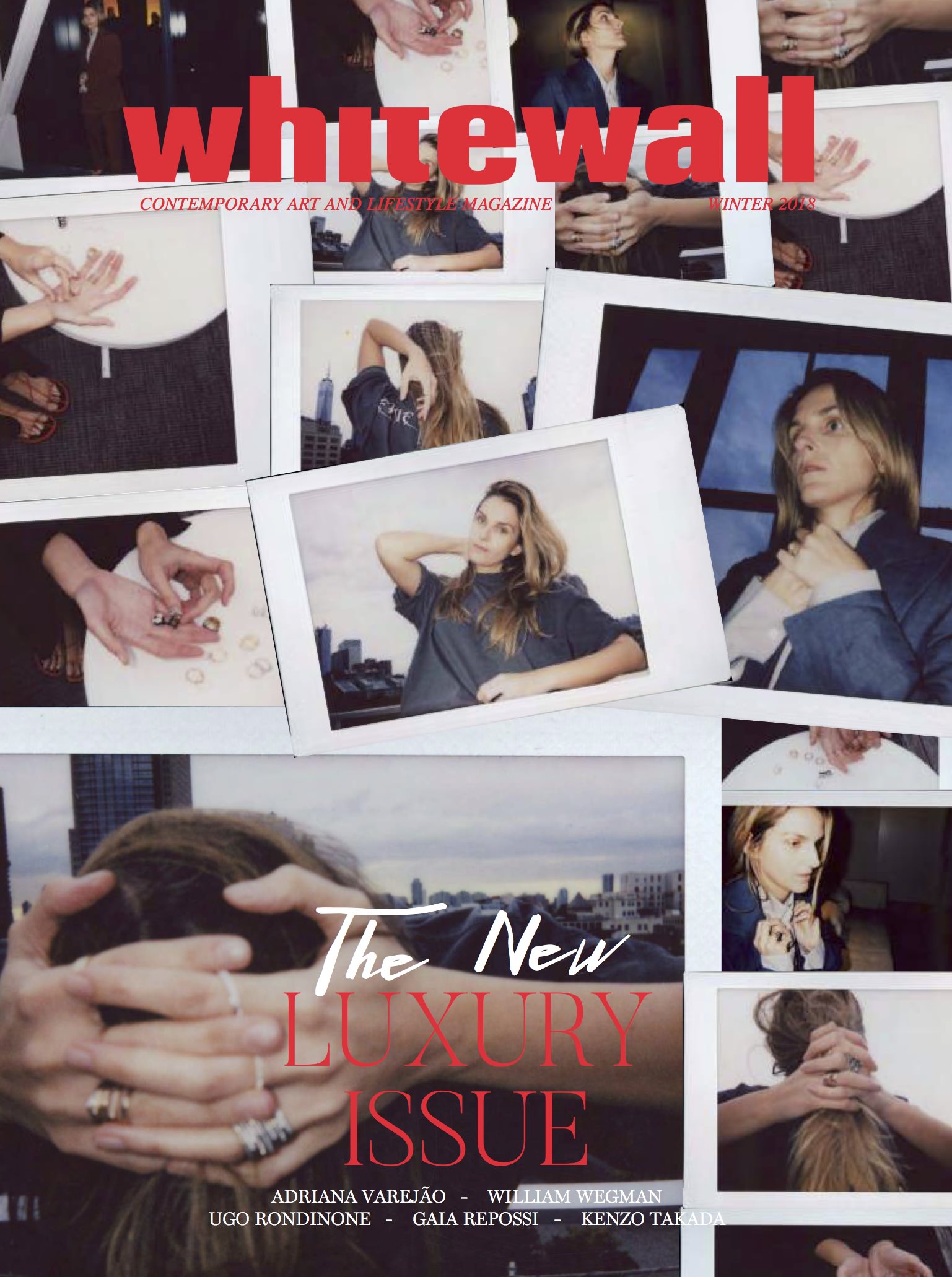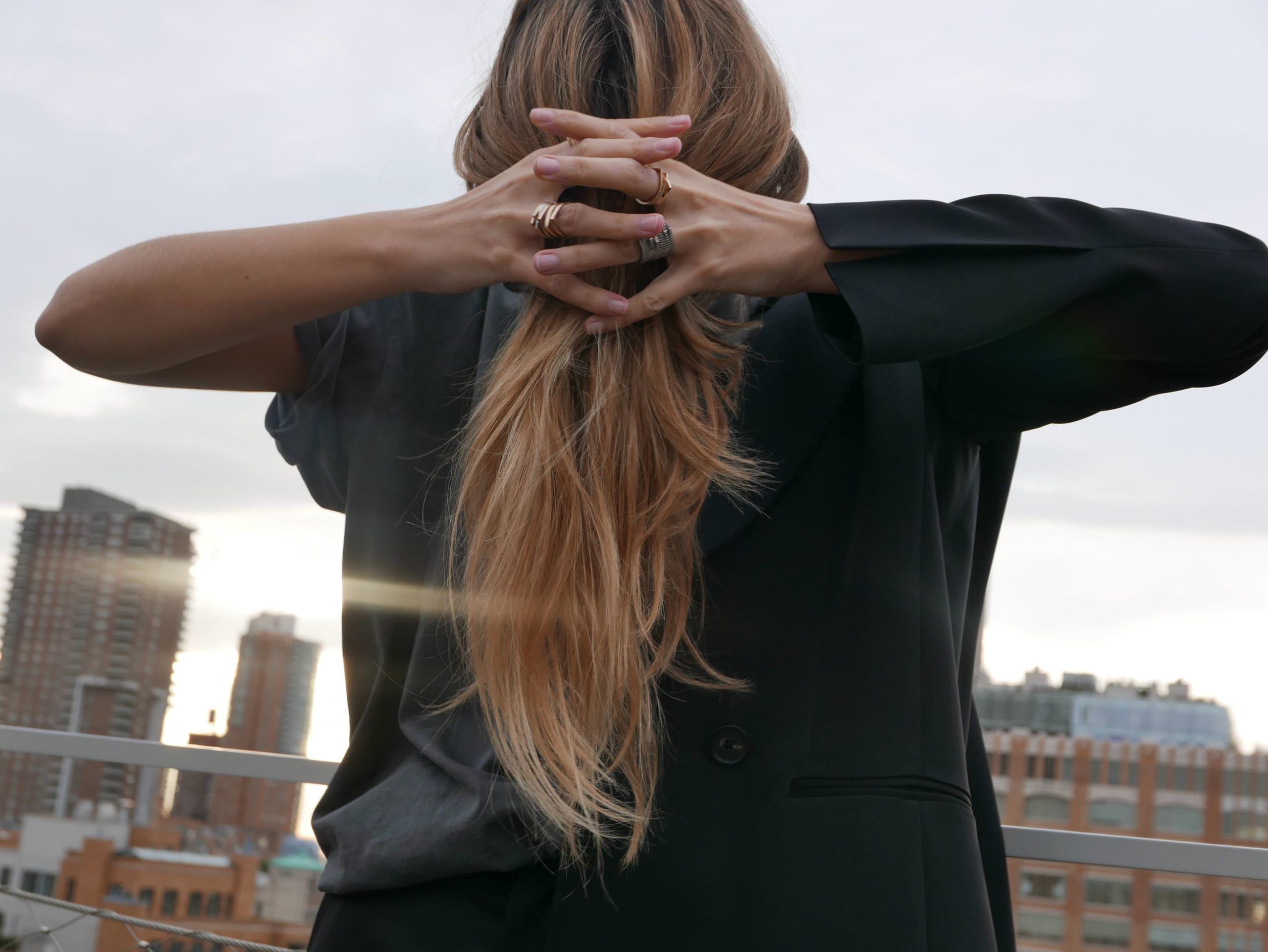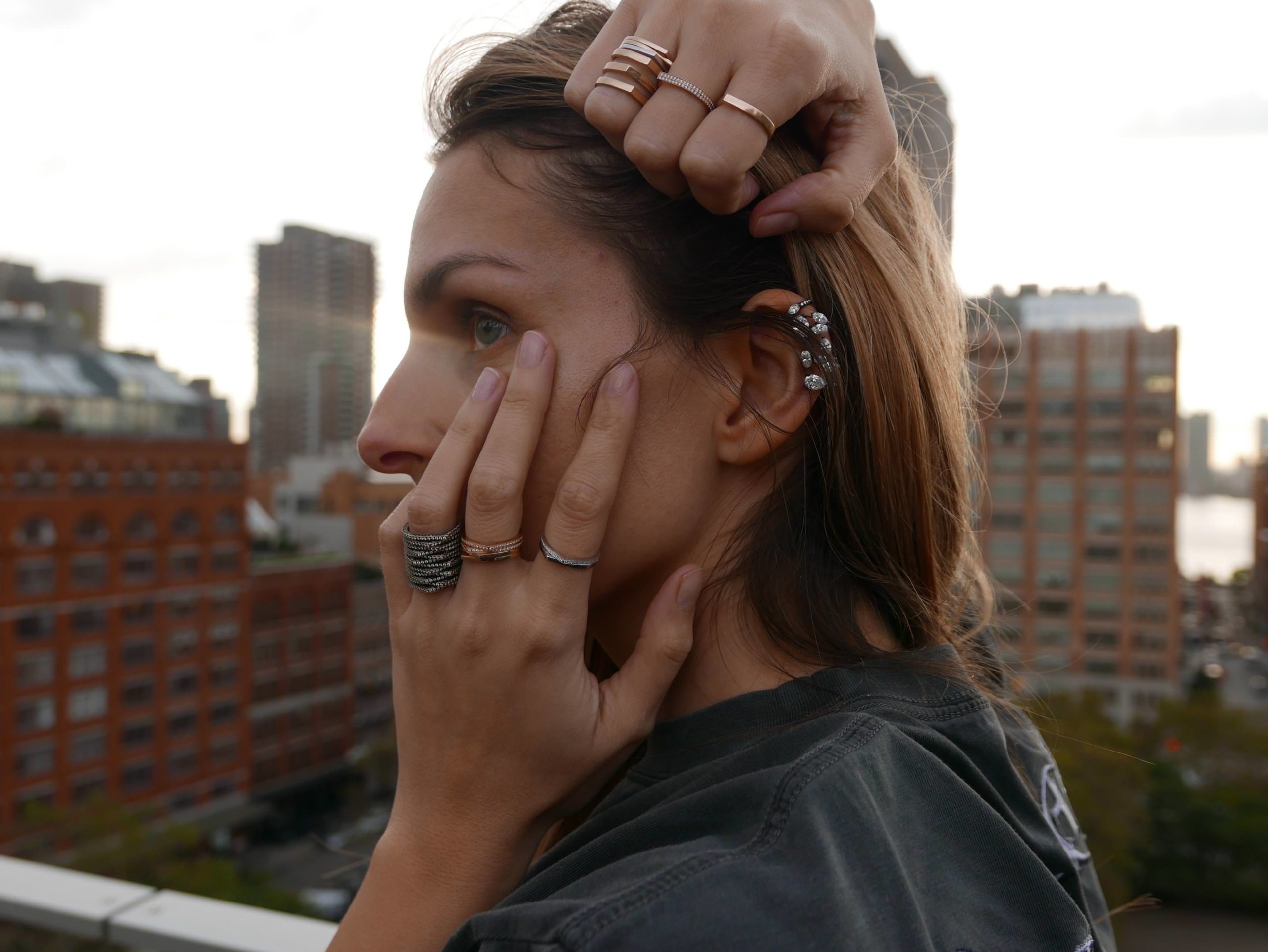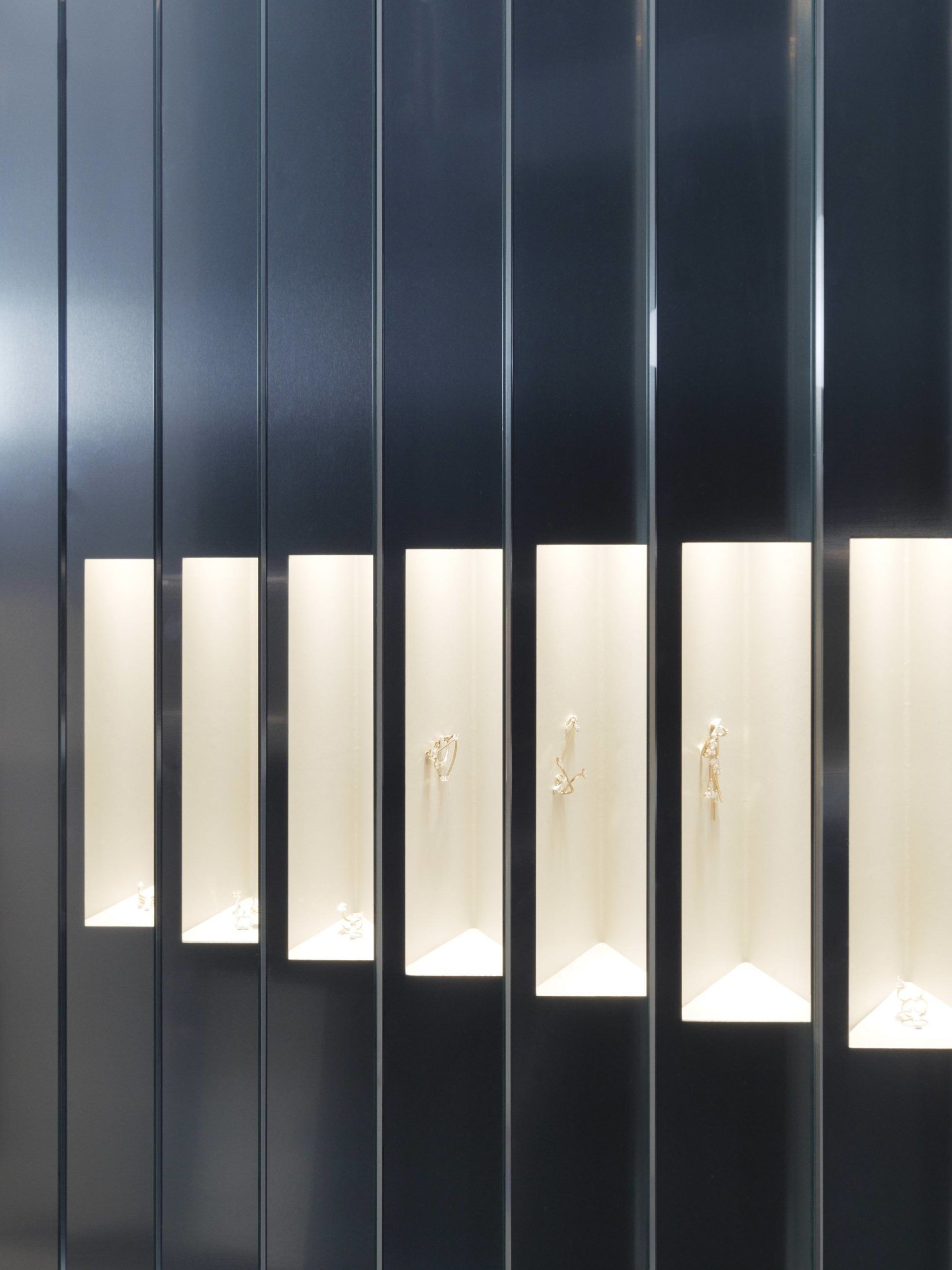Gaia Repossi became the artistic director of her family’s jewelry house—which was founded in 1925—at the early age of 20. With a taste for symmetry, balance, and an understanding of our current moment, she has successfully brought the brand into the 21st century. Her collections are minimal yet edgy. Rings are stackable, hinged, and concentric. Earrings are cuffed, kinetic, and suspended. Cuffs are reminiscent of a Cy Twombly scribble or Bernar Venet sculpture.
Repossi’s designs are a clear extension of the body, almost ritualistic in the way they adorn the hand, neck, ear, or wrist. Stones are placed naturally, as if growing out of the precious metal’s form. She continues to challenge the house’s atelier, breaking tradition, finding a new way to express opulence, and even adding an element of punk.

Whitewall’s winter 2018 New Luxury Issue
Whitewall spoke with Repossi about archaeology, art, and entering her necklace phase.
WHITEWALL: You studied painting and have a degree in archaeology. Was art a part of your life early on?

Photo by Tallulah Harlech
Taken at Spring Place in New York
GAIA REPOSSI: When I was a child I could draw, like my father and grandfather (one used to paint, the other used to be a designer in the forties, before becoming jewelers). That was, for me, the beginning of a very vibrant part of my life. At home, my father was very driven by classical paintings and ancient objects that he would collect. Later, as a teenager, I discovered contemporary art. It was an immense aesthetic shock. I remember two encounters: the abstract room at the Tate Modern in London when I was 17; and a Picasso monograph that was given to my parents when I was 15. It changed me forever.
WW: While studying archaeology, what struck you about the human tendency to adorn the body, or create jewelry?

Photo by Tallulah Harlech
Taken at Spring Place in New York
GR: Coming from a “traditional” yet audacious family background of jewelers, or with the French scholar education, I was taught independence, disruption, and “intellectual” rebellion. Following in my father’s steps didn’t seem like an option.
I think coming from this family background, a lot of knowledge is stored within yourself, whether you want it or not, then comes the desire for disruption. And probably instinct plays a key role.

Photo by Tallulah Harlech
Taken at Spring Place in New York
At Sorbonne, my first impulse was a thirst for mythology and human identity—to be able to visualize certain civilizations and their aesthetic. Anthropology was about understanding inner human kind and tribes. A great mental adventure, my thesis was based on the concept of death throughout the ages and civilizations, and how it interacted. But the surprise was among remnants of art crafts I studied—the amount of jewelry and codes of adornment I encountered. It unleashed such a visual understanding. So much beauty and narrative was exposed to me.
WW: When you began at Repossi, you said that you were looking to dust off the brand, bring it into the 21st century. And then you got inspired, recognizing that jewelry isn’t just decoration; you live with it. When did that click for you?

Photo by Tallulah Harlech
Taken at Spring Place in New York
GR: The desire for disruption was immediate. I couldn’t express anything in a world ruled by numbers or conservative aesthetics. Questioning the existing norms, people started being driven by a couple designs, proposing a narrative or an identity that would be received.
WW: How did that realization affect your design approach?

Photo by Tallulah Harlech
Taken at Spring Place in New York
GR: To me, an object has to follow the ergonomics of the body, suited for the new life women and men live nowadays, what they want to express, a relevant dialogue with their costume (or today’s trends—why not?). Women want to be avant-garde. And, of course, a relevant design. After all, it should give justice to this old craft that is jewelry, to elevate it to its contemporary status.
WW: How would you define that new Repossi language you created?

Repossi’s Paris flagship
Courtesy of Repossi
GR: Off the grid and timeless at the same time. It’s a contemporary sophistication, keeping alive a very old tradition.
WW: Where do you start with a collection? What role does sketching play for you?

Repossi’s Paris flagship
Courtesy of Repossi
GR: Sketching is emptying my guts fast, and impulsively. All my teenage years, I used to paint. It never left me. I’m not a traditional patient jeweler. At all. Sketching gives life to my ideas on the body. There is always a figure. But it’s far from the perfect object that will be conceived that jewelry requires. It sets the tone.
WW: How important is symmetry in your designs?
GR: It’s essential. The body is symmetrical, so the jewelry has to be. I need to stay as close to the body’s reality as possible. Once that first step is there, I can disrupt the symmetry and my own systems.
WW: How do you find balance and consider proportions?
GR: Contemporary jewelry is balanced. It’s impossible today to look relevant with massive unbalanced jewelry. It’s about the right proportions, the right balance in between the actual person and simple shapes. From that balance you can allow outrageous volumes.
WW: Do you have any favorite stones or metals you like to work with?
GR: We are jewelers; we use gold and diamonds. But you cannot imagine the variety among diamonds—pink diamonds of thousands of shades, blue diamonds, green diamonds, milky diamonds. I like flesh-toned diamonds. And black gold allows transgressive design as well.
WW: Do you have a favorite piece you like to design? Ring? Cuff?
GR: I go through phases, and that drives the corporate side of our profession crazy. Ring phase, earring phase. I’m entering the necklace phase.
WW: Where do you find the connection between modernity and opulence?
GR: It’s all about balance, as we said. Modern opulence has been a whole new research phase for me that took a long time, because I was rejecting opulence. Now I’ve found a way to express it. It was a struggle.
WW: Who are you designing for today? Does that ever change or evolve?
GR: It always does. First, she is that woman in the desert. Then she is a punk girl in the streets in a book, or the transgressive boy in his atelier, or the woman who is avant-garde. Then you encounter figures like Isabelle Huppert, Cindy Sherman, or Rem Koolhaas throughout the early stages of you career, and it can’t go without blending.
WW: You challenge your atelier to think of new techniques. Why is that important?
GR: I study new placements on the body with my team. I like surprising. These ateliers are not punk kids; it’s a very difficult task for artisans. To reinvent. But it’s the future and their future as well. There is no other solution.
WW: You’ve cited Franz West, Lee Ufan, Dan Flavin, and Donald Judd as inspiration. What do you connect to in their work?
GR: I discovered Judd late, but the connection, the systems, all the infinite possibilities of his cubes, with slight differences. What a blast meeting Rainer and Flavin Judd. Dan Flavin is the new age colorist to me. Franz West I first disliked, and then his disruptive accents of madness became evident. The persona. Lee Ufan’s book The Art of Resonance, Sugimoto’s concept of emptiness, also describe a state of aesthetic contemplation to me.
I was lucky to meet Sugimoto, exchange with Francesco Vezzoli on jewelry (glamour and antiglamour), Cindy Sherman, Sterling Ruby, and to shake Cy Twombly’s hand. It’s also very important to me to be close to fashion designers, not only artists. Raf, Demna, Karl, Nicolas Ghesquière—they are the oxygen of what is now. They share the same reality.
WW: Any recent exhibitions or works you’ve seen that you’re still thinking about?
GR: Wolfgang Tillmans’s last show at the Tate Modern and his previous New York show at David Zwirner. Unforgettable. So direct, so strong, yet so appealing.
WW: Has a work of art ever inspired a specific piece?
GR: Sometimes. But it can be anything as well—a still from a movie, a part of building, an Art Deco object, a landscape.
WW: This year, you published a book with your boyfriend, Jeremy Everett, Alternating Rose and Gold. What has it been like to create a somewhat personal publication?
GR: It’s hard to reveal yourself so intimately. Only Jeremy and his vision could make me do it. I’m not a millennial. He calls it a love letter to me. I was then very comfortable in his hands. trusting every page. Inez and Vinoodh actually said they found the book very sexual in a subjective way. They are a couple as well.
WW: In your office or home, are the artworks or objects around you to keep you energized, inspired, or grounded?
GR: I’m not what you would call a collector. I find artworks only if they mean something very specific. But art is a language you can’t express with words. They just talk to you and say things words can’t describe. They are part of yourself.
Photographs by Tallulah Harlech, taken at Spring Place in New York.








